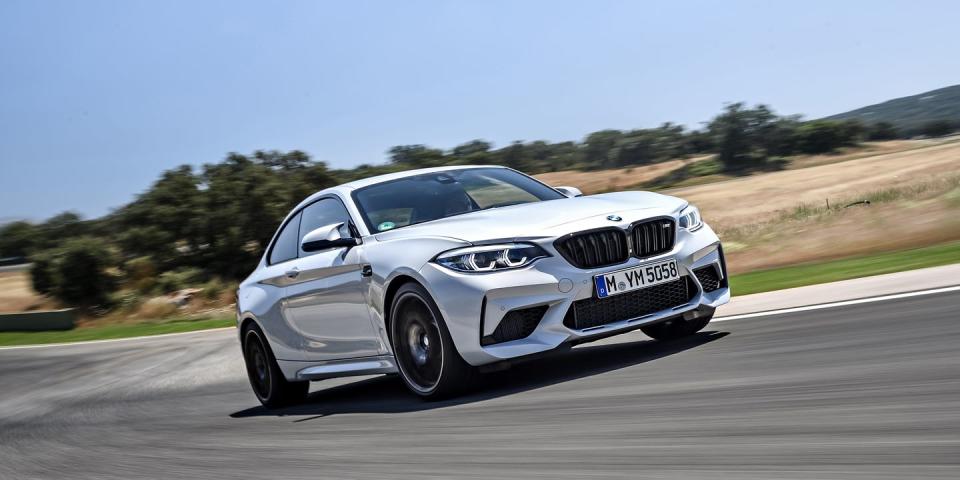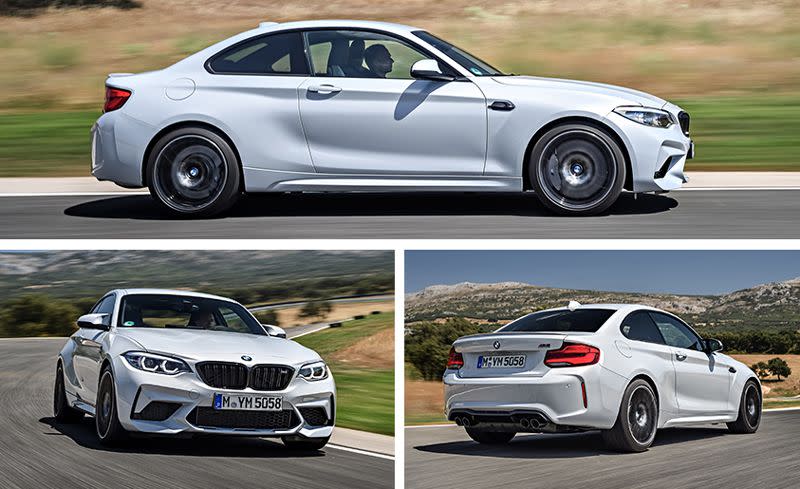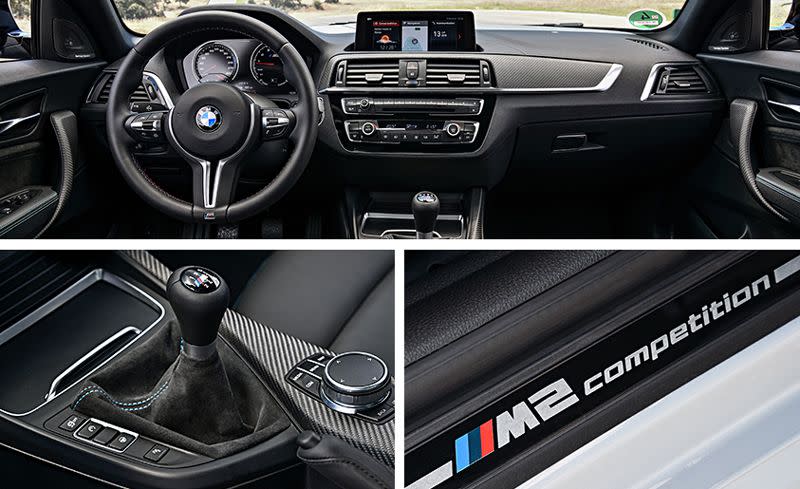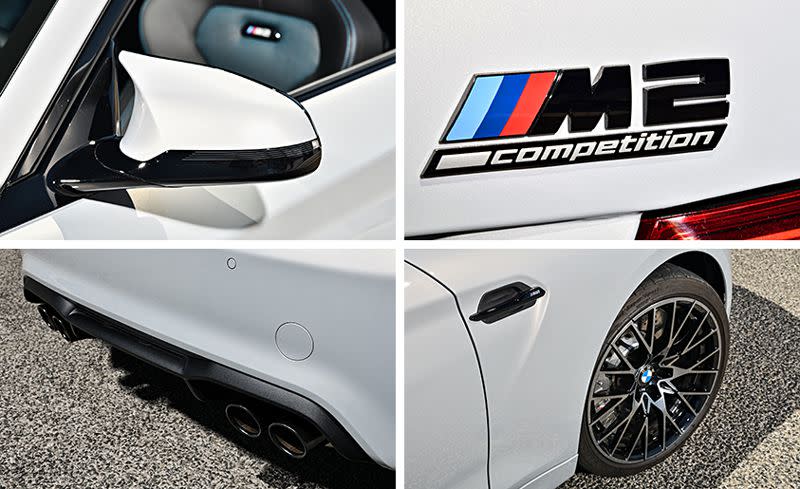2019 BMW M2 Competition

Carved into the mountains of southern Spain east of the historic city of Ronda resides the fast and technical 3.4-mile Circuito Ascari. The racetrack flows smoothly yet is mentally demanding. Linking the chicanes and off-camber sections that comprise the 26 corners requires a sniper’s patience and precision. The straights aren’t so straight and necessitate convincing the brain to go full send. Ascari is a driver’s track, and a course this pure requires a vehicle equal in execution. It’s here that we sampled the 2019 BMW M2 Competition, which supersedes the regular M2 and comes armed with more of everything.
From N to S
BMW could’ve spent wads of cash revising the previous turbocharged N55 inline-six to meet tighter emissions standards. Instead, it snatched a powerplant already in the arsenal, the potent S55 twin-turbo inline-six from the M4. In deference to the M hierarchy, boost is reduced in the M2’s version, lowering the output from 425 horsepower to 405. Torque, however, is undiminished at 406 lb-ft.
Dialing back the S55’s power doesn’t just preserve the M-family pecking order, it also addresses a cooling issue. Although the M2 Competition’s fascia is revised and the cooling system is derived from that of the M4 Competition, the smaller car doesn’t flow as much air through its front end, and less airflow means less cooling. But even detuned to 405 horsepower, the S55’s output represents a substantial increase over the outgoing M2’s 365 horses and 369 lb-ft. The M2 Competition rockets down the straights, and the sweet inline-six barks through a new exhaust system, pulling strongly all the way to the redline.
New Hardware
Assisting with deployment of the newfound power is a welcome piece of hardware, BMW’s Active M rear differential. Revised for work in the M2 Competition, the electronically controlled limited-slip rear diff controls the locking effect to evenly distribute torque across the rear axle in all corners, no matter how wide or sharp. In Dynamic mode, the stability-control intervention is dialed back to be less intrusive, but it remains present should things get out of hand. We found the limits to be well within reason as the pocket-size M2 allows more throttle application during corner exit, carrying graceful slides while at the same time powering out of corners like no M2 has done before.
Thankfully, a six-speed manual remains the standard gearbox. The shifter travels through the gates with precision, even though it retains that characteristic BMW slight rubberiness in its motions. The clutch take-up is spot on, and the transmission automatically rev-matches for you on downshifts. Disabling the rev-matching system requires the complete commitment of also fully deactivating the stability control, but the pedals are spaced perfectly for heel-and-toe downshifts. The other transmission choice is BMW’s quick-shifting seven-speed dual-clutch automatic, a $2900 option. Launch control is specific to the automatic, which also now incorporates BMW’s three-mode Drivelogic, allowing adjustability of the transmission’s shift programming at the push of a button.
The brakes fill nearly every bit of real estate within the new forged 19-inch wheels. The brakes are massive iron rotors-15.7 inches in front and 15.0 in the rear-clamped by six-piston fixed calipers in the front and four-piston fixed calipers in the rear. Even after a day of track abuse, the brake pedal remained firm and the modulation linear.
The suspension calibration is unchanged from the previous non-Competition M2 and still delivers a firm ride. The staggered 245/35ZR-19 front and 265/35ZR-19 rear Michelin Pilot Super Sport tires also are carryovers from the outgoing M2, although more track-friendly, M2-spec, Michelin Pilot Sport Cup 2 rubber will be available from the accessories catalog or through aftermarket suppliers. At the limit, lateral grip remains abundant and understeer is easily managed with the throttle. Through the twists and turns of Puerto del Viento, the chassis feels more eager to turn in than was the previous M2, in part due to the new carbon-fiber front strut-tower brace, another item plucked from the M4. BMW has recalibrated the electrically assisted power steering to play better with the fortified front structure. Unfortunately, any feel from the surface below is still absent.
Logos and More Logos
The cockpit is decked out with even more M2 logos, like on the doorsills and illuminated in the seatbacks of the new and more supportive M Sport buckets. The seatbelts are embroidered with tricolor M stripes, and there’s a red engine-start button. There’s also a new steering wheel with two programmable buttons that can be set to quickly toggle between driving modes. On the outside, new side mirrors, black kidney grilles and badges, and redesigned fascias distinguish the M2 Competition from the former M2.
Sticking to the purist theme, the list of available options is minimal. A sunroof can be had for $1050, and the Executive package adds a heated steering wheel, full LED headlights with automatic high-beams, wireless device charging, and a Wi-Fi hotspot for an additional $1200. The $2500 M Driver’s package raises the top speed to 174 mph and buys a ticket to a course at BMW’s performance driving school.
Starting at $59,895 and on sale now, the 2019 M2 Competition represents a $4400 premium over the 2018 M2. With all the hardware, equipment, and performance bundled into this refreshed bite-size coupe, the upcharge is well worth it. Within the current BMW lineup, the M2 has been the most exciting vehicle from a driver-involvement standpoint, and the Competition version is even more so.
('You Might Also Like',)

 Yahoo Autos
Yahoo Autos 


